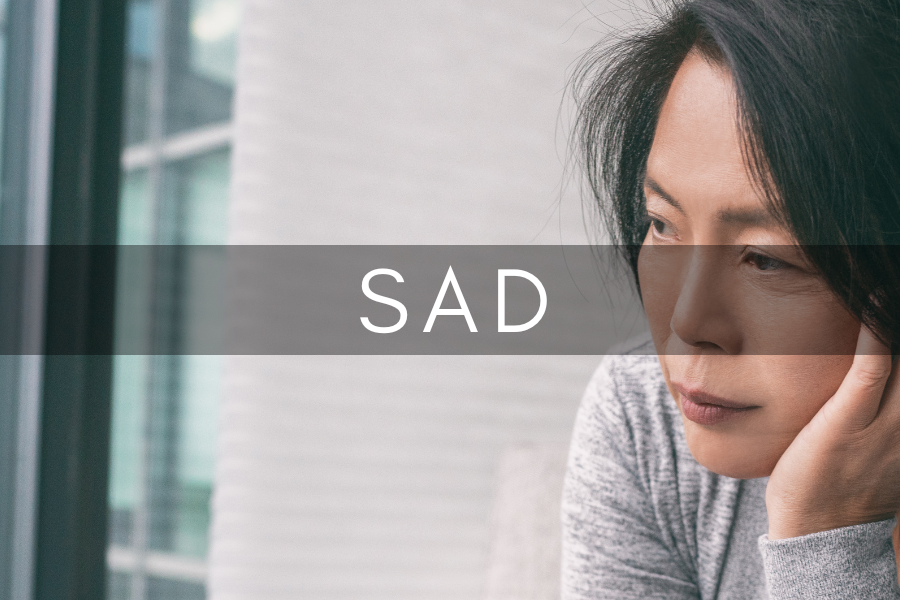
A guide to Seasonal Affective Disorder (SAD) | Symptoms and Causes
What is seasonal affective disorder?
Seasonal affective disorder, or SAD, is a type of depression that a person can experience at certain times of the year (most likely as seasons change). Many people with SAD find that their depressive symptoms begin in the autumn, and then continue into the dark and cold months of winter, as the lack of natural daylight causes fatigue and low mood. Most people with SAD find that their symptoms are better or disappear entirely during the months of spring and summer, when the days are longer and there is more natural daylight.
Many symptoms of SAD revolve around the autumn and winter months, although some people can find they experience depression and SAD symptoms in the spring and summer months, too, although this is more rare. Treatments for SAD include psychotherapy, medications, supplements and light therapy (phototherapy). While it's common for many people to feel more sluggish and less motivated during the winter months, if low mood is causing a problem for everyday life and preventing a person from doing everyday activities, including sleep and eating habits, depression may be a cause. In this case, it's important to speak to a doctor.
Symptoms of seasonal affective disorder
Normal depression and SAD have many symptoms in common, but SAD symptoms typically start in autumn and progress through winter, until they start to improve in spring. The severity of SAD symptoms can vary from person to person. Indications of SAD include:
- A low mood that is continuous or for very persistent periods
- Lack of interest or pleasure in hobbies or activities that are usually enjoyed
- Irritable mood
- Feelings of worthlessness, guilt or despair
- Stress
- Low self-esteem
- Low libido
- Feeling tense and anxious
- Feeling less sociable
- Manic episodes (in severe cases)
- Lethargy
- Insomnia and difficulty in falling asleep
- Lack of concentration
- Craving unhealthy and carbohydrate foods
If you or someone you know is experiencing any of the above symptoms and you suspect SAD or some other form of depression, you should consult with your doctor.
What causes seasonal affective disorder?
It's unknown what exactly causes SAD, or if there is a specific underlying cause. It's often linked to a lack of exposure to natural sunlight in the late autumn and winter time. There's a theory that some people are more prone to experiencing SAD because of their genes, but this is unproven. Another reason could be that a lack of sunlight can prevent an area of the brain (the hypothalamus), from working properly. This can lead to affected production of melatonin – a hormone that makes you feel sleepy. In people with SAD, the body produces more of this hormone than normal levels. It can also affect serotonin production levels. Serotonin is a hormone that affects mood, and is known as the 'happy hormone'. It can also affect appetite and sleep. SAD also impacts your body's circadian rhythm, which acts like its natural clock. Your circadian rhythm is responsible for important functions like when you wake up, feel hungry, etc. Symptoms of SAD can disrupt this internal clock.
Misconceptions about seasonal affective disorder
There's still a lot of misunderstanding when it comes to SAD, and it can be dismissed as 'the winter blues'. Having SAD is more than just feeling low in winter time. There are several factors that can make it worse, as it's a form of depression. It can be frustrating if people don't understand how the symptoms can affect you. By knowing your rights, talking openly about your mental health, reaching out for help and showing others reliable information, you can hopefully better educate others about SAD and any associated misconceptions.
Diagnosing SAD
You should visit your GP if you believe you have symptoms of SAD. Your GP will assess your mental health, and will likely ask you questions about your lifestyle, eating patterns, sleeping patterns, personal history, family medical history and mood. They'll also ask you how your mood changes between warmer and colder seasons. They'll discuss with you how long your symptoms last, their severity, and the extent to which they prevent you from doing everyday activities. It can take a while for SAD to be formally diagnosed.
Self-care tips for coping with SAD
There are some things you can do to take care of yourself if you have SAD symptoms.
1. Go outside in daylight hours: Even if it's cloudy, rainy or cold – in the winter, a decrease in the number of daylight hours can affect your mood. Make the most of daylight hours in the autumn and winter, and get outside as much as possible. Even a cloudy day will still give your body and brain the daylight it needs.
2. Let the sunlight in: Let as much sunlight into your working environment and home as possible. If you spend a lot of time indoors, like working from home, open all curtains and blinds and sit near a window that lets the sunlight in. You can also surround yourself with greenery and position multiple house plants around rooms to help your body feel as though you're outside.
3. Eat a healthy and balanced diet: People with SAD symptoms can crave sugary, fatty and carbohydrate-based foods. Make sure you give your brain and body a healthy, balanced diet with a range of healthy fats, nuts, oils, fruit and vegetables, fish, meat and healthy grains. Avoid drinking alcohol and caffeine, as these can make SAD symptoms worse. Drink plenty of water instead.
4. Take exercise outdoors: Doing regular activity outside can help with a low mood and aid those who are feeling the symptoms of depression. It can be cycling, walking, running or whatever you feel like doing. Exercise outdoors can also help you to sleep better at night.
5. Keep a journal of how you're feeling: It can help to keep a print or digital version of how your mood is on a day by day basis, so you can keep track of how you're feeling as weeks pass. By making a note of any SAD symptoms, you can track any patterns in line with the weather and seasons. You can also identify what makes you feel better, and what makes you feel worse. In your journal, plan some relaxing and calming activities, and talk about how they made you feel.
6. Keep stocked up: In the winter time, when the days are dark and cold and you don't want to go outside, it can help to keep cupboards full. This can mean keeping extra stocks of things you need like toiletries, cleaning products and food, and freezing down meals for when you don't feel like cooking, or going outside to get groceries.
Can supplements help with SAD?
Some vitamins can regulate biochemical reactions in the brain, which help with cognitive function. Vitamins can also help with any nutritional imbalances that may be contributing to SAD symptoms. If you're looking to support your health this winter, you can take any of the following:
Vitamin D
Vitamin D supplements are advised by the government during the winter months. This is because our bodies create less Vitamin D when the days are shorter in winter. Many of us have a Vitamin D deficiency during winter time, which can make us feel lethargic, tired and achy. Taking Vitamin D supplements can also improve sleep.
Iron
Iron helps our bodies to produce red blood cells, which carry oxygen. We can become iron-deficient without enough iron in our diets, which can cause tiredness and fatigue. Taking iron supplements can help to boost energy levels during the winter time.
Vitamin B
Vitamin B helps us release energy from our food, and helps us produce red blood cells that send oxygen around the body. Taking Vitamin B supplements can help with fatigue, low mood and weakness in people with SAD.
By Panasha Desai, Pharmacist




